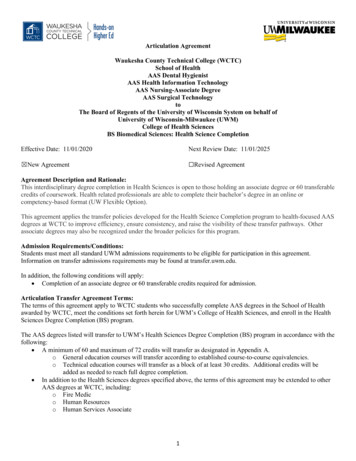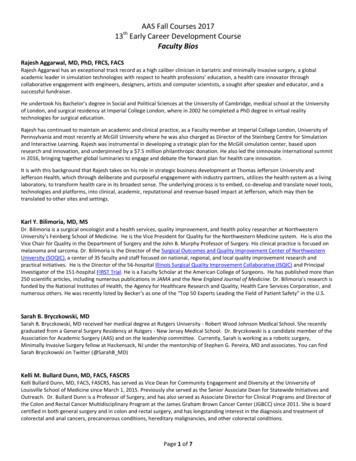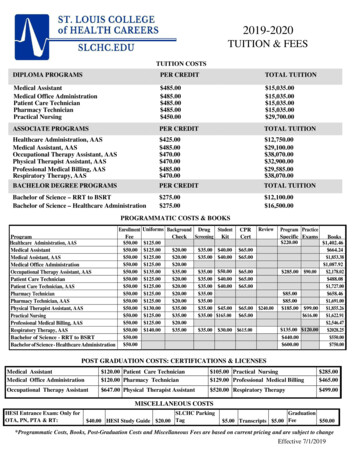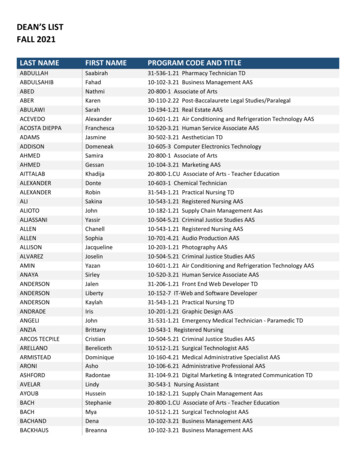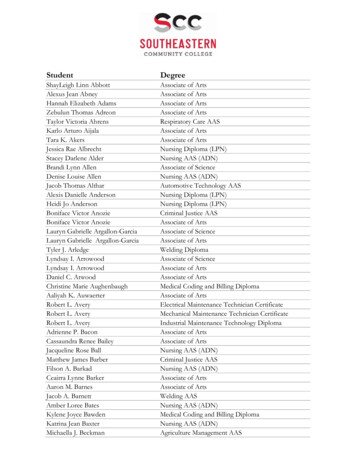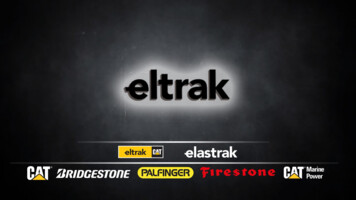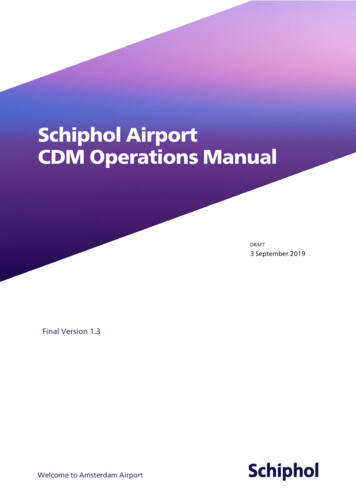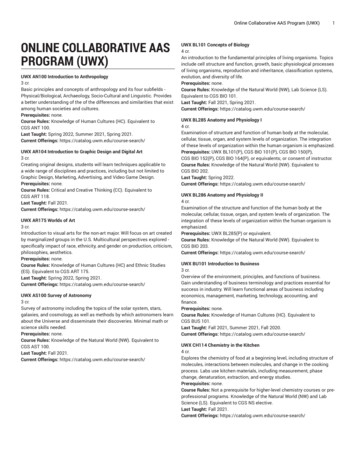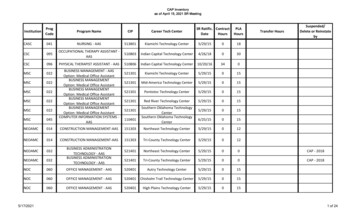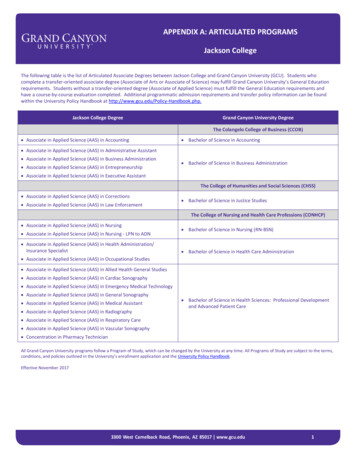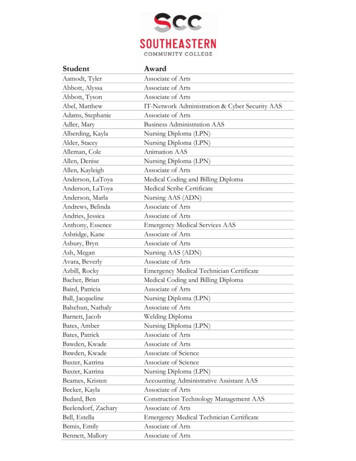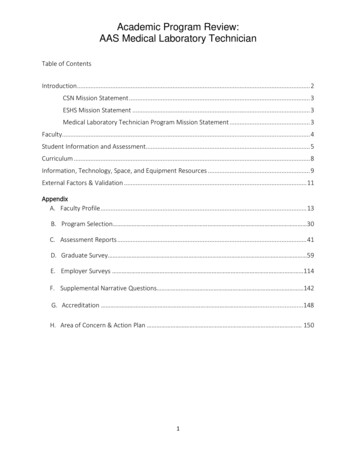
Transcription
Academic Program Review:AAS Medical Laboratory TechnicianTable of ContentsIntroduction . 2CSN Mission Statement . 3ESHS Mission Statement . 3Medical Laboratory Technician Program Mission Statement . 3Faculty. 4Student Information and Assessment. 5Curriculum . 8Information, Technology, Space, and Equipment Resources . 9External Factors & Validation . 11AppendixA. Faculty Profile . 13B. Program Selection 30C. Assessment Reports . 41D. Graduate Survey 59E. Employer Surveys . 114F. Supplemental Narrative Questions 142G. Accreditation .148H. Area of Concern & Action Plan . 1501
Academic Program Review:AAS Medical Laboratory TechnicianIntroductionThe Medical Laboratory Technician Program prepares students to work in all areas of the clinical laboratory(i.e., hematology, chemistry, blood bank, immunology, microbiology and urinalysis). Courses in each of thedisciplines mentioned above are presented in both lecture and laboratory format. Additionally, studentsare assigned to several local laboratories to obtain clinical experience at scheduled times during theprogram. The general education requirements for the AAS degree in Medical Laboratory Technologyinclude coursework designed to develop the basic and critical thinking skills necessary for effectivecommunication and problem solving. Math and science courses provide the necessary foundation forunderstanding concepts covered in professional courses.Upon successful completion of the program, students will be awarded an Associate of Applied Sciencedegree, and become eligible to challenge a national certification examination. Students who pass aqualifying certification examination are eligible for Nevada state licensure as a Medical LaboratoryTechnician.2
Academic Program Review:AAS Medical Laboratory TechnicianCollege, School, Program Mission StatementsCSN Mission StatementThe College of Southern Nevada creates opportunities and enriches lives with inclusive learning andworking environments that support diversity and support student success. The College fosters economicdevelopment, civic engagement, and cultural and scientific literacy, while helping students achieve theireducational, personal, and professional goals.https://www.csn.edu/our-missionESHS Mission StatementThe mission of the Engelstad School of Health Sciences (ESHS) is to provide high quality, student-centeredcertificate and degree programs that meet the needs of state and local communities.Medical Laboratory Technician ProgramThe mission of the Medical Laboratory Technician Program is to provide learning experiences that allowstudents to acquire theory, and develop laboratory techniques and critical thinking skills necessary tooperate successfully in a clinical laboratory setting.The Medical Laboratory Technician Program mission statement and outcomes have been developed basedon industry and certification standards. The program mission supports the CSN mission as the programsupports student success in their educational, personal, and professional goals of pursuing a career in theMedical Laboratory field. Additionally, student success, institutional effectiveness, and economicdevelopment are supported by graduation rates of 97% and placement rates of 100% for 2017-2018 asreported to the National Accrediting Agency for Clinical Laboratory Sciences (NAACLS).3
Academic Program Review:AAS Medical Laboratory TechnicianFacultyThe Clinical Laboratory Science Programs employ one program director, three full-time faculty,one research associate, and one administrative assistant, which is shared with one other program.Faculty perform ongoing evaluation of lecture and laboratory topics and activities. Course syllabiare reviewed and updated to complement current clinical practice. Faculty are required to obtainappropriate continuing medical education, and this is reflected in revisions to class materials.The program employs part-time faculty, as needed, who have the appropriate educationalbackground and clinical expertise. Minimum credentials for part-time faculty include abaccalaureate degree, and a national certification as a medical laboratory scientist/medicaltechnologist, medical laboratory technician or phlebotomist, dependent on the courserequirements. Part -time faculty are primarily hired to teach laboratory courses, as they are usuallyactively practicing individuals capable of conveying current technical practices to the students.Practicing medical laboratory scientists/medical technologists, medical laboratory technicians,and phlebotomists serve as clinical affiliate site instructors for students during scheduled clinicalrotations. Clinical instructors have appropriate credentials and/or Nevada state licensure for theirrespective positions.Please see Appendix A for faculty profiles.4
Academic Program Review:AAS Medical Laboratory TechnicianProgram SelectionThe Medical Laboratory Technician (MLT) Program is a Limited Entry Program, and accepts 12students per year. Applications are submitted to the Office of Limited Entry Admissions,processed, and reviewed for consideration. Only the top-applicants are selected for entry.Selection is based on a point system, and selection criteria is available to students on thewebsite. See Appendix B for application and selection criteria.Students applying to the MLT program must have a minimum GPA of 2.0 or higher for programprerequisites which include Biology, Chemistry, English, and Math courses. Students mustmaintain a C or better (75% or higher) in all program courses in order to remain in the program.The AAS-MLT degree is a 66-credit degree which includes general education and programspecific courses, that complies with NSHE, College, and NAACLS accreditation guidelines.Student Completion InformationStudent completion information is provided annually to NAACLS, to the Dean of Health Sciences,and posted on the College of Southern Nevada-Medical Laboratory website. NAACLS requiresreporting of a three-year rolling average. Data are noted below. Placement rates includeemployment in a related area and/or pursuing educational goals.Academic YearGraduation RatePlacement 0%2017-201897%100%Student Learning OutcomesThe student learning outcomes of the College of Southern Nevada Medical LaboratoryTechnician program are to ensure that graduates are competent in the areas of professionalpractice listed below:1.Assess and correlate clinical and/or laboratory data through application of theory andprinciples.2.Perform and/or interpret laboratory calculations.5
Academic Program Review:AAS Medical Laboratory Technician3.Select appropriate courses of action in accordance with established laboratoryprocedures.4.Evaluate laboratory data to recognize and report clinically relevant results according toestablished procedures.AssessmentThe Medical Laboratory Technician Program assessment plan is an ongoing system forperiodically and systematically reviewing the effectiveness of the program. In a continuing effortto provide quality education in clinical laboratory science, the MLT Program incorporatesfeedback from several sources in performing program review and evaluation. Responses andcomments received from these sources are considered in planning curriculum and learningactivities for future MLT students.Annual Assessment ReportsThe College of Southern Nevada requires annual assessment of programs and program coursesaccording to a multi-year plan. The current plan for the MLT program concentrates on reviewand/or revision of educational outcomes/learning competencies in selected courses. Seeappendix C for College Assessment Reports and the ESHS LEAP Assessment for the MLT Program.Graduate SurveysIn order to continue to meet the needs of future students, the MLT Program solicits input fromgraduates by requesting that they complete a survey rating their knowledge and technical abilityin each major clinical area. Students are asked to comment on Program and College resources,as well as the quality of instruction received at clinical affiliate sites. Students are also asked tosubmit specific demographic information regarding type of employment and future educationalplans. The remaining survey questions pertain to the overall effectiveness of the program.Students are asked to comment on program strengths, weaknesses, instrumentation, specificimprovements, faculty, and preparation for national certification. See appendix D for the mostrecent results.Employer SurveysIn order to meet the future needs of the medical community, the CLS Programs (MLT and MLS)solicit input from potential employers by requesting that they complete a similar surveypertaining to student knowledge and technical ability in each of the major clinical areas.Employers are also asked to submit specific demographic information regarding the type ofclinical facility, number of beds, employment of graduates, and importance of phlebotomy skills.Employers are also given an opportunity to make specific recommendations as to how the CLSPrograms can better prepare graduates to function competently in the clinical setting. Seeappendix E for the most recent results.6
Academic Program Review:AAS Medical Laboratory TechnicianStudent Evaluation of InstructionUpon completion of each course, students are given an opportunity to evaluate instruction bycompleting an on-line evaluation provided by the College. In addition to expressing theiropinions on the course and didactic instructor, students are also asked to consider courseorganization, expectations and class discussion in their evaluation. Overall, students andgraduates are satisfied with courses and instruction.Students are also given an opportunity to evaluate clinical instructors and the overall practicumexperience by completing a form contained in each practicum notebook.Practicum EvaluationsClinical instructors rate student performance of designated tasks on a scale of 1 to 5(unacceptable to outstanding performance). There is a separate page in the practicum notebookfor each task. Upon completion of a specific group of tasks, the student receives an overallperformance evaluation, which includes an assessment of punctuality, attendance, accuracy,productivity, ability to learn, acceptance of criticism, communication and organization of timeand resources.Advisory CommitteeThe Advisory Committee is composed of the Program Director, program faculty, communitymembers and representatives from the clinical affiliate sites. The Advisory Committee meets atleast annually to evaluate curriculum changes and address program concerns.7
Academic Program Review:AAS Medical Laboratory TechnicianCurriculum InformationMedical Laboratory TechnicianCertification Pass RatesCertification pass rate information is provided annually to NAACLS, to the Dean of Health Science, andposted on the Medical Laboratory website. NAACLS requires reporting of a three-year rolling average.Data are noted below:Academic YearASCP Certification Pass RateAMT Certification Pass 0%2017-2018100%N/A-graduates did not challengethis exam during the reportingperiodCurricular AnalysisStudent performance overall is above average, with graduation rates, certification pass rates, andgraduate employment, or continued education, above the benchmarks set by the National AccreditingAgency for Clinical Laboratory Sciences. Certification pass rates have increased over the preceding fouryears. No curricular changes at this time. Faculty will continue to monitor.Practicum Evaluation: After faculty discussion, the notation of ‘Critical Parameters’ has been added topracticum evaluations. Students must earn a MPL rating of 3 or better on critical parameters; overalltask areas; and/or performance area/professionalism, as determined by the clinical site. Criticalparameters include basic laboratory skills critical for safe patient care, both for the overall clinicallaboratory and specific discipline, as well as the soft-skills of professionalism.Action: Addition of “Critical Parameter” to practicum evaluations beginning Summer 2018.Result: To date, all students have met critical parameters.The Medical Laboratory Technician program has traditionally been run as a five-semester program.Problems involving Financial Aid due to the low number of credits per semester and student concerns ofthe amount of time for program completion have driven a change in the curriculum offering.Action: Create a program track shortening the number of semester’s in-program from five to three. Thisplan is due to take effect in Fall 2020, allowing students to finish the program in one-calendar year.Result: Student success will be monitored with the compressed program. No data at this time.8
Academic Program Review:AAS Medical Laboratory TechnicianInformation, Technology, Space and Equipment ResourcesMedical Laboratory TechnicianLibrary ResourcesLibrary resources include a number of Health Science related databases, publications and periodicals.Additional resources are available to the students in CLS classrooms.Computer AccessComputer access and software programs are sufficient for program students.Computers connected to the Internet are available in CLS student laboratories for student use. Wi-Fi isavailable for student use throughout the campus. An academic computing center is located in the "C"building on the Charleston Campus as well as in the CSN library. Computers with a variety of tutorialsoftware and word processing programs are available for student use during weekday, weekend andevening hours. Students can utilize these computers to access and print instructional materials requiredby program faculty.FacilitiesClassroom/laboratory space for the program is sufficient.Each classroom assigned for CLS didactic instruction contains adequate seating for students, awhiteboard, PC/DVD combination, overhead projector and retractable viewing screen with SMARTClassroom Technology.Classroom/laboratory spaces are connected to a laboratory preparation room. The prep room containschemical storage cabinets, an autoclave, flask scrubber, computers, refrigerators, freezer, biological andchemical safety hoods, a reverse osmosis system, and a deionized water filtration system. There aretwo fire extinguishers, (2) eyewash stations, a safety shower, fire blanket, and a hazardous spill clean-upkit. This room is also equipped with a negative-pressure ventilation system. A copy/fax machine is alsolocated in this area.Each permanent faculty and staff member has an office equipped with a telephone, computer, lockingdesk and file cabinet, and bookshelves. Security personnel also have card keys to the office doors.Faculty and staff computers are connected to a network system for printing and Internet access. Apassword is required for computer access. Fax and copy machines are located in faculty office commonwork area.One administrative assistant is assigned to support the Clinical Laboratory Sciences Programs. Theadministrative assistant’s area is equipped with a telephone, locking desk, computer, printer, and faxand copy machines.9
Academic Program Review:AAS Medical Laboratory TechnicianQuality of facilities maintenance is generally adequate, however, response and notification ofenvironmental issues is sometimes slow or non-existent. Excessive heat in student laboratory spaces inlate spring, summer, and early fall have caused incidences of students, and faculty, feeling ill and lightheaded. Students are required to wear laboratory coats and gloves for laboratory exercises; doors to thelaboratory spaces cannot be propped open due to security concerns; and the use of fans is prohibited asstudents are working with biohazardous substances. This has been an on-going concern for a number ofyears, with no acceptable solution. Additionally, excessive heat also causes the equipment in thestudent laboratories to malfunction.Unreliable power to department refrigerators and freezers have cost the program/College thousands ofdollars in replacement costs for reagents. A plan is in place for backup generators that will hopefullyaddress this issue.Instructional EquipmentEquipment in the laboratory science program has been a critical component to the success of ourstudents in the clinical setting. Each major clinical laboratory discipline (i.e., Microbiology, Hematology,Urinalysis, Blood Bank, Clinical Chemistry) is equipped with automation similar to instrumentation usedin the clinical/hospital laboratories. Accreditation site visitors were impressed with our studentlaboratory experience, stating it was one of the best in the nation.New technological advances and instrument malfunction require the updating of equipment in someareas.The automated analyzer in the Clinical Chemistry laboratory is 12 years old and running on Windows2000 software. It has recently become inoperable for the majority of the photometric testing performedin the student laboratory. The manufacturer no longer supports this analyzer. The program has pursuedapproval for a new analyzer for the last two years. The program will again request Perkins funding toreplace this analyzer.The automated analyzer in the Hematology laboratory is no longer in working order. The program hasspent over 5000 to repair the analyzer, and unfortunately, other internal workings have now failed.Without the ability to purchase extended maintenance agreements, repairs sometimes are costprohibitive. The program will request Perkins funding to replace this analyzer.10
Academic Program Review:AAS Medical Laboratory TechnicianExternal FactorsMedical Laboratory TechnicianEnrollment TrendsThe Medical Laboratory Technician (MLT) program is a Limited Entry program. Approximately 30-40qualified applicants apply to the MLT program each year. Twelve students are selected each year.Applicants earn points toward selection based on a number of factors such as grade point average ofdesignated program prerequisite courses, completion of higher-level chemistry courses, and completionof a phlebotomy course of study, among others.Student to faculty ratio is 12 to 1 in lecture and student laboratory courses. The AAS-MLT program is theonly program in the state among NSHE institutions.Program Graduate DemandAs reported to the National Accrediting Agency for Clinical Laboratory Sciences, the three-year averageplacement rate, which includes graduate employment and/or pursuing additional education, is 100%.Graduate SatisfactionOverall, graduates are satisfied with the professional preparation of the MLT program. According to theMLT graduate survey results from 2014-2017, eight of eleven respondents ranked their professionalpreparation as good-excellent as related to discipline specific issues, and eight of nine respondents rankedtheir ability to perform technical procedures as good-excellent. Eight of eight respondents rated thequality of classroom instruction as excellent.Graduates also identified areas of improvement for the program including additional funding for updatedequipment and reagents, and to add a review course for board exam preparation.Unique ElementsThe Medical Laboratory Technician program is the only NAACLS accredited program in the State ofNevada. Small class sizes allow for one-on-one instruction, if needed, for students. Well-equipped studentlaboratories encourage student interaction with the equipment that is necessary for the function ofmedical laboratories.Challenges facing the program are not unique to the College of Southern Nevada, however, are commonfor medical laboratory education. Medical laboratories are becoming increasingly corporatized, andtherefore, services are consolidated to optimize finances. For the education sector, this equates to fewerclinical placement sites especially in Microbiology and Transfusion Medicine (Blood Bank). Due to thelimitation of clinical placements, the number of students accepted into the program now is 12.Funding for equipment, consumables, maintenance, and repair was decreased due to a decrease in Statefunding a number of years ago. While the funding levels have been steady since then, services and11
Academic Program Review:AAS Medical Laboratory Technicianreagents increase annually. As previously mentioned, program graduates also have concerns aboutprogram funding.The MLT program graduates have a 100% placement rate. While most MLT graduates are continuing tothe MLS program, graduates are filling positions in the community. According the U.S. Bureau of Laborstatistics, job prospects for Medical Laboratory Technicians are best for persons who complete anaccredited educational program and earn a professional certification. Nationally employment rates areexpected to increase by 14%, and in the State of Nevada the projection is 21%.External ValidationAccreditationThe Medical Laboratory Technician program is accredited by the National Accrediting Agency for ClinicalLaboratory Sciences (NAACLS). NAACLS accredits a variety of programs in health-related fields and isrecognized by the Council for Higher Education Accreditation (CAHEA). Recognition by CAHEA affirmsthat standards and processes of accrediting organizations are consistent with quality improvement, andaccountability expectations that CAHEA has established. NAACLS also confirms the Code of GoodPractice of the Association of Specialized and Professional Accreditation. NAACLS contact information isprovided below:National Accrediting Agency for Clinical Laboratory Sciences5600 N. River Road, Suite 720Rosemont, IL, 60018-5119Ph.: 773-714-8880Fax: 773-714-8886E-mail: info@naacls.orgwww.naacls.orgPlease see Appendix G for notice of accreditation award.12
Appendix A: FacultyHeidi C. Schneiter231 W. Kimberly DriveHenderson, NV 89015EDUCATIONUniversity of Nevada, Las VegasLas Vegas, NevadaMaster of Education in Curriculum and InstructionEmphasis: Career and Technical and Post-Secondary Education, 2013University of Wisconsin-OshkoshOshkosh, WisconsinBachelor of Science/Letters and Science Medical TechnologyMinor: Chemistry, 1986CERTIFICATIONSAmerican Society of Clinical Pathologists (ASCP)Certified Medical Technologist #169458 1986 to presentLICENSUREState of Nevada Department of Health and Human ServicesLicensed General SupervisorClinical Laboratory Technologist #2092TGS-10 1993 to presentASSOCIATIONS American Society for Clinical PathologyAssociate Member 1986 to presentAmerican Society for Clinical Laboratory ScienceProfessional I Member 2012 to presentACADEMIC EXPERIENCECollege of Southern NevadaLas Vegas, NevadaProgram Director 4/2014 to presentClinical Laboratory Science ProgramProfessor 2015 to presentInterim Program Director 7/2008 to 4/2014Clinical Laboratory Science Program13
Appendix A: FacultyInstructor 8/2004 to presentClinical Laboratory Science ProgramPublications and PresentationsGordon, H. R. D., Schneiter, H., & Bryant, R. (2016). Staff members’ perceptions of student- veterans’transition. Educational Research: Theory & Practice, 28(1), 1 – 14.Gordon, H. R. D., Schneiter, H., & Bryant, R. (2016). Academic faculty members’ perceptions of studentveterans’ transition. Educational Research: Theory & Practice, 28(2), 1 – 8.Paper Session: Presented at American Public Health Association Annual ConferenceOctober 31, 2016Staff Members’ Perceptions of Student Veterans’ Transition at a Public Two-Year and Four-Year InstitutionHoward Gordon, University of Nevada, Las VegasHeidi Schneiter, College of Southern NevadaRoss Bryant, University of Nevada, Las VegasPaper Session: Presented at Northern Rocky Mountain Educational Research Association AnnualConferenceOctober 7, 2016Academic Faculty Members' Perceptions of Student-Veterans' TransitionHoward Gordon, University of Nevada, Las VegasHeidi Schneiter, College of Southern NevadaRoss Bryant, University of Nevada, Las VegasBreakout Session: Presented at Nevada Public Health AssociationAnnual ConferenceSeptember 23, 2016Steff Members' Perceptions of Student-Veterans' Transition in Southern Nevada: Implications for PublicHealthHoward Gordon, University of Nevada, Las VegasHeidi Schneiter, College of Southern NevadaRoss Bryant, University of Nevada, Las VegasVanessa Winn, College of Southern Nevada14
Appendix A: FacultyCOLLEGE OF SOUTHERN NEVADA SERVICECollege Assessment Council 2015-2016Faculty Senate Curriculum Committee 2016 to presentGeneral Education Curriculum Committee 2016 to presentStrategic Enrollment Planning Committee, Member 2013 to 2016College Student Success Committee 2015-2018Faculty Senator, Member 2006 to 2011; 2018 to presentScience and Technology Expo 2005 to presentHiring Committees2014-Dental Hygiene Instructor (chair of committee)2014-Clinical Laboratory Science InstructorENGELSTAD SCHOOL OF HEALTH SCIENCES SERVICEProgram Directors Committee, Member 2008 to presentClinical Laboratory Science Advisory Committee, Chair 2009 to presentESHS Assessment Committee 2015-presentESHS Strategic Planning Committee 2017 to presentClinical Laboratory Science Advisory Committee, Member 2005 to 2008Limited Entry Selection Committee, Member 2008 to presentLimited Entry Policy Committee, Member 2012 to presentCurriculum Committee, Member 2012 to presentCurriculum Committee, Chair 2016 to presentDevelopment and Implementation of BAS-MLS degree 2010-2012COMMUNITY SERVICEScience and Technology Expo 2005 to presentHealth Career Explorations Camp 2018CLINICAL EXPERIENCEQuest DiagnosticsLas Vegas, NevadaClinical Chemistry DepartmentSupervisor/Technologist 2/2000 to 10/2007Associated Pathologist LaboratoryLas Vegas, NevadaHematology; Clinical Chemistry; UrinalysisTechnologist 12/1993 to 7/199815
Appendix A: FacultyThe Blood Center of Southeastern WisconsinMilwaukee, WisconsinHemostasis LaboratoryTechnologist 12/1991 to 12/1993Kaukauna Community HospitalKaukauna, WisconsinLaboratory Manager/Technologist 12/1991 to 2/1993St. Elizabeth’s HospitalAppleton, WisconsinShift Supervisor/Technologist 9/1986 to 12/199116
Appendix A: FacultyPatricia Armour1401 Nadine WayBoulder City, Nevada 89005pat armour@icloud.comEDUCATIONDoctor of Philosophy– Health Related SciencesJuly, 2013-June, 2018Major: Clinical Laboratory ScienceVirginia Commonwealth University (VCU)Richmond, VirginiaDissertation: Usefulness of the CaptiaTM Syphilis IgG EIA test method andreverse algorithm for detection of syphilis infection in a public health settingMaster of Public AdministrationJanuary, 2008-August, 2011University of Nevada Las Vegas (UNLV)Las Vegas, NevadaBachelor of Science-Medical TechnologySeptember, 1969-May, 1973University of Wisconsin-Superior (UW-S)Superior, WisconsinInternship - Medical TechnologyMay, 1972-May, 1973St. Luke’s HospitalDuluth, MinnesotaLICENSURE AND CERTIFICATIONMedical Technologist (ASCP) #087074Issued October 17, 1973State of Nevada General Supervisor Clinical Laboratory Technologist #93TGS-8Issued January 13, 2003WORK EXPERIENCEFaculty Instructor – Medical Laboratory ProgramAugust, 2016 – presentCollege of Southern NevadaLas Vegas, Nevada Current tenure track instructor for Certificate, Associate, and Bachelor level lecture and laboratorycourses in Clinical Laboratory Science phlebotomy, hematology, microbiology, laboratory operations,and reviewParticipated in student assistance and advisement, specifically for prospective phlebotomy studentsMaintained five hours per week office hoursParticipated in multiple college service activities including ESHS Summer Explorations Camp for ClarkCounty School District (CCSD) High School Juniors and Seniors17
Appendix A: Faculty Participated in multiple professional development activities including 2016 and 2018 renewal of NevadaState General Supervisor license with completion of 20 Continuing Education (CE) hours for eachrenewal period and poster presentation at the CSN 6th Annual Poster Fair on Student Success in January2019Chairman, College of Southern Nevada (CSN) Engelstad School of Health Sciences (ESHS) StrategicPlanning TaskforceCommittee member ESHS Interprofessional Education committeeCommittee member ESHS Program Director/Huddle committeeCommittee member ESHS Scholarship committeeCommittee member CSN Faculty Senate Salary and Benefits committeeLaboratory Manager/Responsible Official/Technical SupervisorJune, 2003 - August, 2016Southern Nevada Health DistrictLas Vegas, Nevada Established new branch of Nevada State Public Health Laboratory, the Southern Nevada Public HealthLaboratory (SNPHL), to perform eme
The Medical Laboratory Technician Program prepares students to work in all areas of the clinical laboratory (i.e., hematology, chemistry, blood bank, immunology, microbiology and urinalysis). Courses in each of the disciplines mentioned above are presented in both lecture and laboratory format. Additionally, students .
